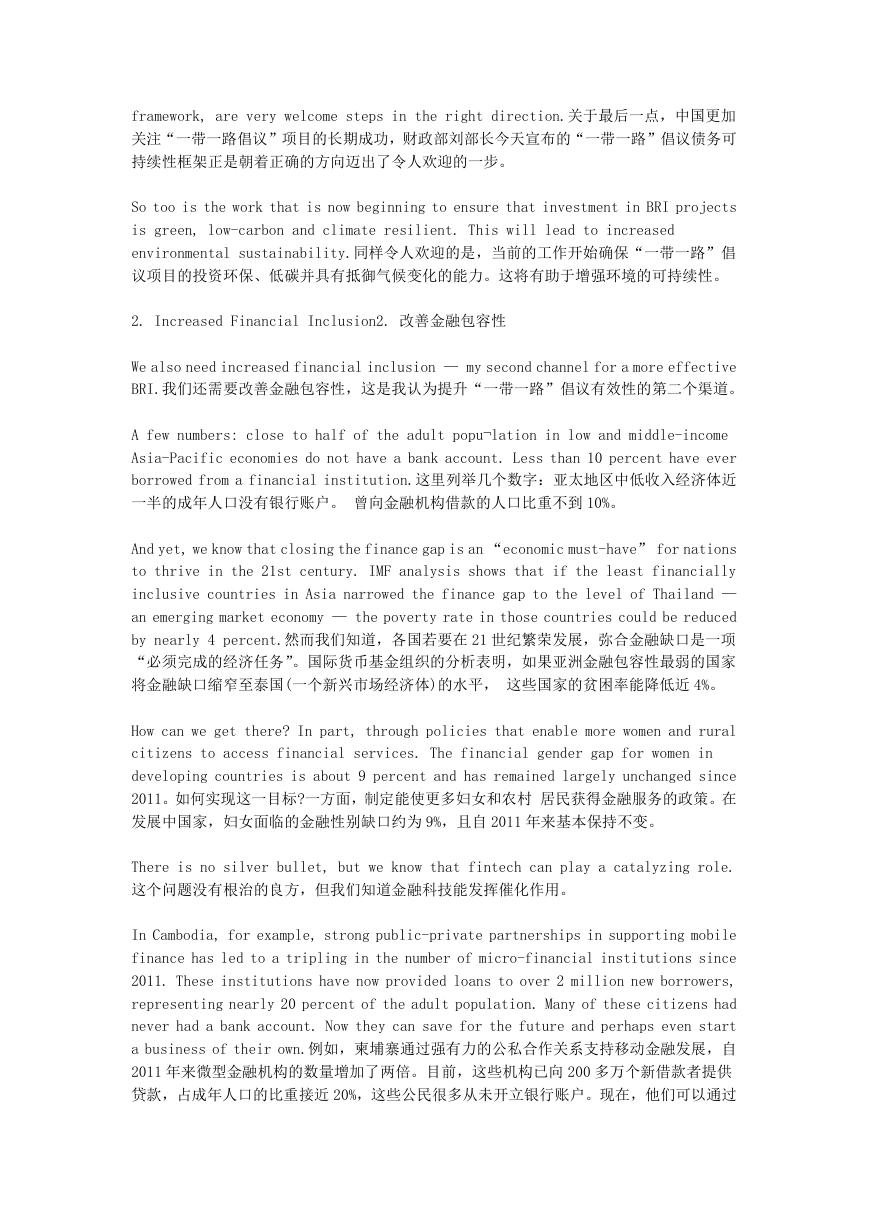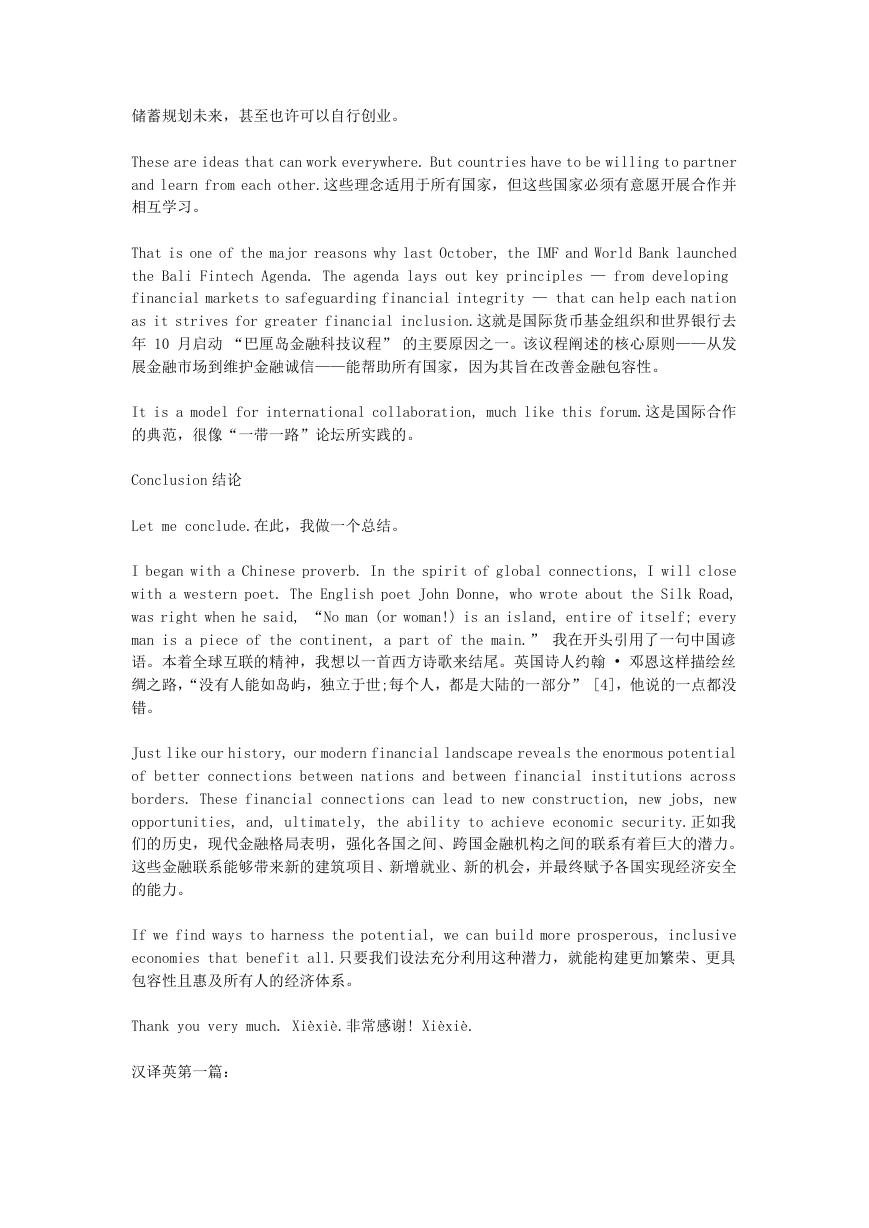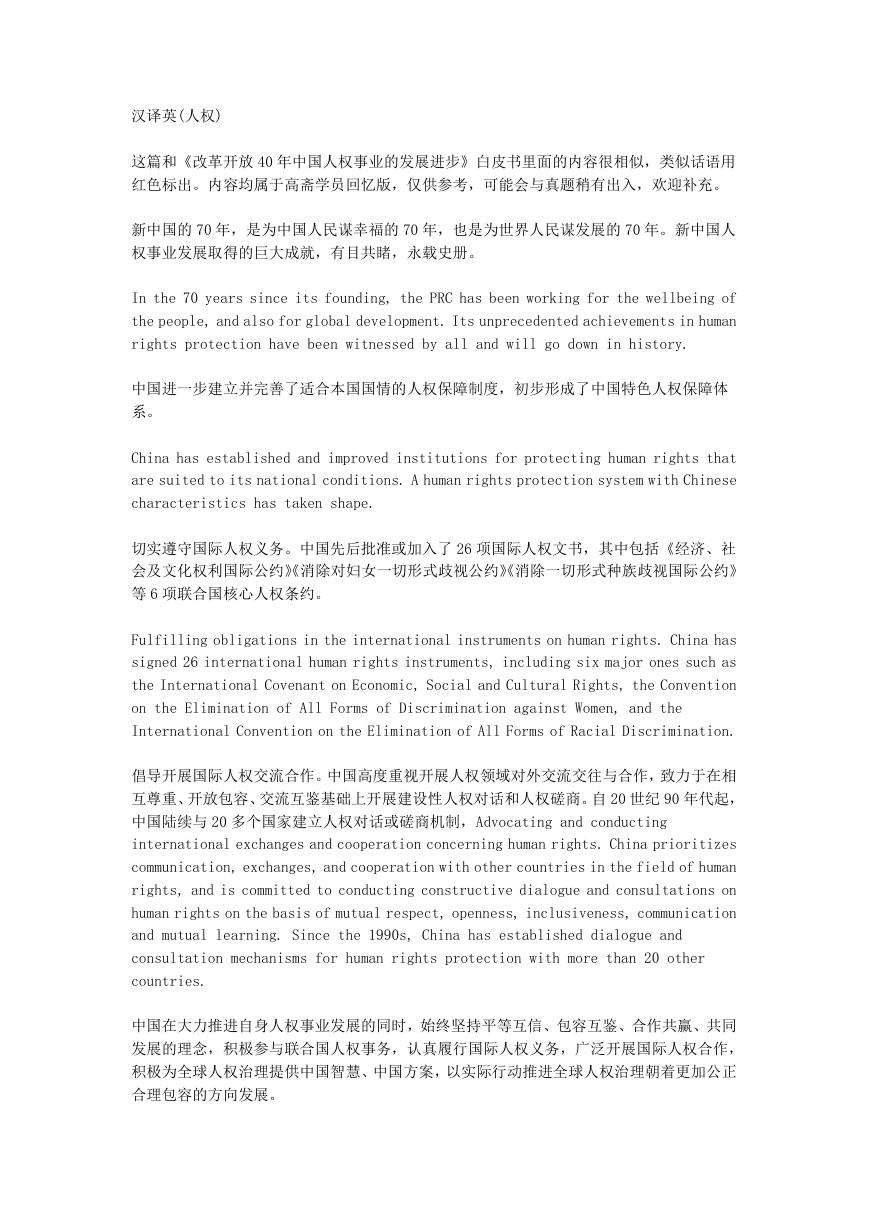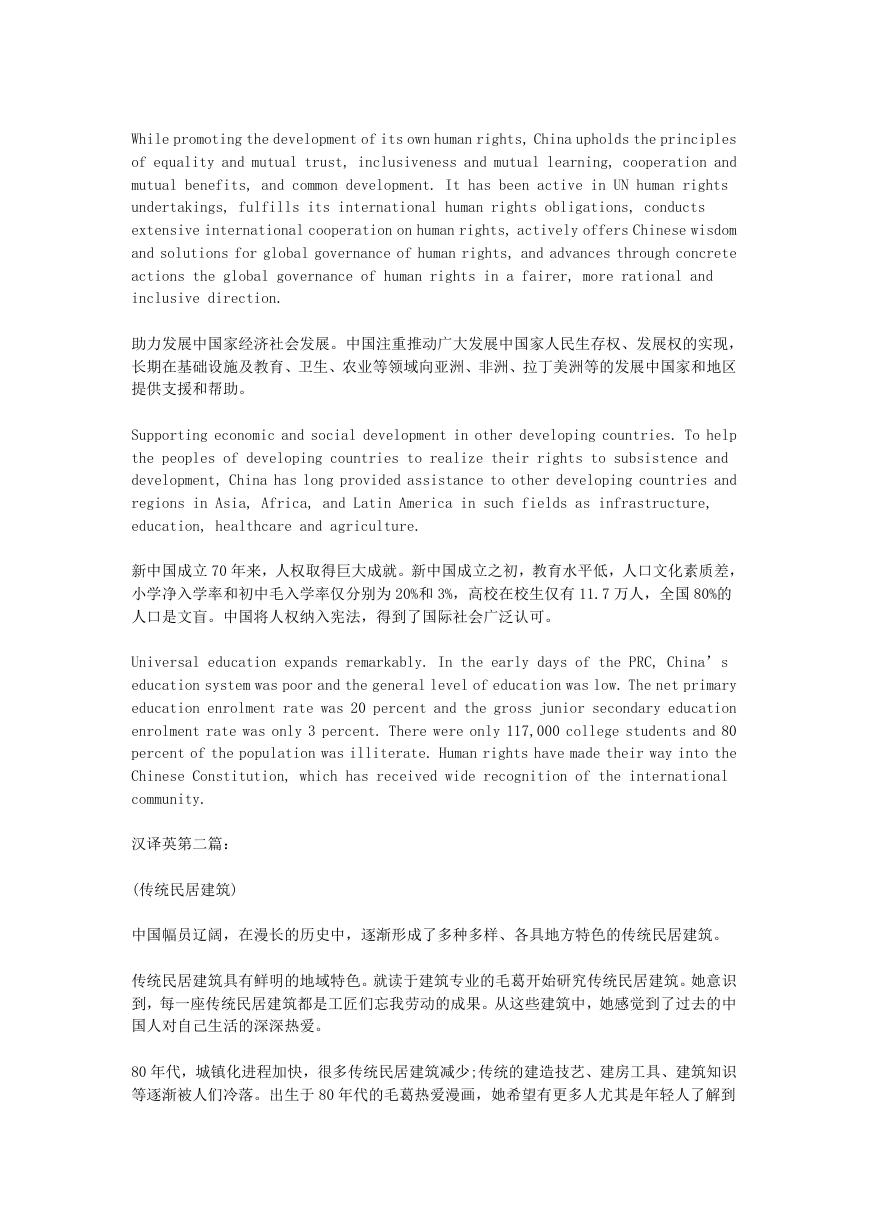2019 年 11 月翻译资格考试二级英语笔译实务真题及答案
Passage 1
“一带一路”倡议:实现金融互联互通的两个关键渠道开幕致辞国际货币基金组织总裁 克
里斯蒂娜 • 拉加德“一带一路”论坛,金融互联互通会议
Belt and Road Initiative: Two Key Channels to Achieving Financial
ConnectivityOpening RemarksBy Christine Lagarde, IMF Managing DirectorBelt and Road
Forum Session on Financial ConnectivityApril 24, 2019
Governor Yi, Minister Liu, Distinguished Guests, Ladies and Gentlemen — good
morning! Zao Shang Hao!易行长,刘部长,尊敬的嘉宾,女士们、先生们——早上好! Zao
Shang Hao!
I would like to thank the People’s Bank of China and the Chinese Ministry of Finance
for organizing this important event.首先,我想对中国人民银行和中国财政部组织这场
重要的会议表示感谢。
As we meet during this beautiful springtime weather it brings to mind the words of
the Chinese proverb, “ The whole year must be planned for in the spring.”在这
个美丽的春天相聚,让人想起一句中国谚语——“一年之计在于春”。
Over the next three days we will consider the ways the Belt and Road Initiative —
the BRI—can help better connect the world physically and financially for years to
come. It is fitting that we begin these conversations with financial connectivity.
Why? Because history teaches us that physical and financial connectivity go
hand-in-hand.在接下来的三天中,我们将讨论未来若干年“一带一路”倡议将如何增进世
界各国在基础设施和金融层面的互联互通。我们不妨从金融互联互通谈起。为什么?因为历
史告诉我们,基础设施和金融的互联互通是相伴而行的。
Think of the original Silk Road. The desire for trade drove merchants to travel
thousands of kilometers. Over time, infrastructure in the form of bridges, buildings,
and even entire new cities were built to accommodate what began as small trading
posts and financial exchanges.想想古代的丝绸之路。通商的愿景促使商人千里跋涉。随
着时间流逝,人们修建桥梁、建筑等基础设施,甚至建起整座新城,来满足最初规模较小的
贸易站和金融往来的需求。
So where there is financial connection, we see that rapid improvements in quality
of life can quickly follow.哪里形成了金融联系,当地的生活质量就会很快改善。
In our modern context, there are several important channels to achieving this greater
financial connectivity. I want to highlight two today: increased capital mobility
and increased financial inclusion.在现代背景下,更深层次的金融互联互通可以通过几
�
个重要渠道来实现。我今天想强调两个渠道:加强资本流动和改善金融包容性。
1. Increased Capital Mobility1. 加强资本流动
First, enabling capital to flow more freely.第一,确保资本更自由地流动。
Allowing capital to flow across borders can help support inclusive growth. How? By
enhancing investments in infrastructure, manufacturing, and even health care.允
许资本跨境流动能帮助支持包容性增长。如何支持?通过促进基础设施、制造业甚至医疗行
业的投资。
Right now, foreign direct investment —FDI — is only 1.9 percent of GDP in
developing countries. Before the global financial crisis, it was at 2.5 percent.
Making progress on major infrastructure needs will require capital flows to rise
again and to be managed safely.目前,发展中国家的外国直接投资(FDI)仅占 GDP 的 1.9% ;
而在全球金融危机之前,这个数字是 2.5% 。为推进主要基础设施建设进展,需要再次增加
资本流动规模,并以安全的方式对其进行管理。
Greater openness to capital flows can also bring down the cost of finance, improve
the efficiency of the financial sector, and allow capital to support productive
investments and new jobs.对资本流动更加开放也能降低融资成本,提高金融部门效率,
允许资本支持生产性投资和新增就业。
That is certainly the case here in China, where a further opening of the bond market
to foreign investors will enable diversification and foster the
internationalization of the Renminbi (RMB).这对中国尤为适用。中国向境外投资者进
一步开放债券市场,能够 实现债券市场投资者多元化,并促进人民币国际化。
In fact, the IMF recently published a book on this topic, called “The Future of
China’s Bond Market”. It outlines how the inclusion of China’s bonds in global
indexes can be a gamechanger not only for China’s own financial markets but also
for global investors.事实上,国际货币基金组织近期就这一专题出版了一本题为《中国
债券市场的未来》的新书。它概述了中国债券纳入全球指数会如何给中国金融市场以及全球
投资者带来巨大变化。
The book also underscores the challenges that come with opening up capital markets.
Thankfully, we know from experience the elements that are required for success. These
include sound financial regulation, transparent rules for investment, and attention
to fiscal sustainability. 该书还强调了资本市场开放带来的挑战。幸运的是,我们从经
验中获悉了成功所需的要素,包括完善的金融监管 、透明的投资规则以及关注财政可持续
性。
On this last point, China’s increased focus on the long-term success of BRI projects,
and the announcement today by Finance Minister Liu of a BRI debt sustainability
�
framework, are very welcome steps in the right direction.关于最后一点,中国更加
关注“一带一路倡议”项目的长期成功,财政部刘部长今天宣布的“一带一路”倡议债务可
持续性框架正是朝着正确的方向迈出了令人欢迎的一步。
So too is the work that is now beginning to ensure that investment in BRI projects
is green, low-carbon and climate resilient. This will lead to increased
environmental sustainability.同样令人欢迎的是,当前的工作开始确保“一带一路”倡
议项目的投资环保、低碳并具有抵御气候变化的能力。这将有助于增强环境的可持续性。
2. Increased Financial Inclusion2. 改善金融包容性
We also need increased financial inclusion — my second channel for a more effective
BRI.我们还需要改善金融包容性,这是我认为提升“一带一路”倡议有效性的第二个渠道。
A few numbers: close to half of the adult popu¬lation in low and middle-income
Asia-Pacific economies do not have a bank account. Less than 10 percent have ever
borrowed from a financial institution.这里列举几个数字:亚太地区中低收入经济体近
一半的成年人口没有银行账户。 曾向金融机构借款的人口比重不到 10%。
And yet, we know that closing the finance gap is an “economic must-have” for nations
to thrive in the 21st century. IMF analysis shows that if the least financially
inclusive countries in Asia narrowed the finance gap to the level of Thailand —
an emerging market economy — the poverty rate in those countries could be reduced
by nearly 4 percent.然而我们知道,各国若要在 21 世纪繁荣发展,弥合金融缺口是一项
“必须完成的经济任务”。国际货币基金组织的分析表明,如果亚洲金融包容性最弱的国家
将金融缺口缩窄至泰国(一个新兴市场经济体)的水平, 这些国家的贫困率能降低近 4%。
How can we get there? In part, through policies that enable more women and rural
citizens to access financial services. The financial gender gap for women in
developing countries is about 9 percent and has remained largely unchanged since
2011。如何实现这一目标?一方面,制定能使更多妇女和农村 居民获得金融服务的政策。在
发展中国家,妇女面临的金融性别缺口约为 9%,且自 2011 年来基本保持不变。
There is no silver bullet, but we know that fintech can play a catalyzing role.
这个问题没有根治的良方,但我们知道金融科技能发挥催化作用。
In Cambodia, for example, strong public-private partnerships in supporting mobile
finance has led to a tripling in the number of micro-financial institutions since
2011. These institutions have now provided loans to over 2 million new borrowers,
representing nearly 20 percent of the adult population. Many of these citizens had
never had a bank account. Now they can save for the future and perhaps even start
a business of their own.例如,柬埔寨通过强有力的公私合作关系支持移动金融发展,自
2011 年来微型金融机构的数量增加了两倍。目前,这些机构已向 200 多万个新借款者提供
贷款,占成年人口的比重接近 20%,这些公民很多从未开立银行账户。现在,他们可以通过
�
储蓄规划未来,甚至也许可以自行创业。
These are ideas that can work everywhere. But countries have to be willing to partner
and learn from each other.这些理念适用于所有国家,但这些国家必须有意愿开展合作并
相互学习。
That is one of the major reasons why last October, the IMF and World Bank launched
the Bali Fintech Agenda. The agenda lays out key principles — from developing
financial markets to safeguarding financial integrity — that can help each nation
as it strives for greater financial inclusion.这就是国际货币基金组织和世界银行去
年 10 月启动 “巴厘岛金融科技议程” 的主要原因之一。该议程阐述的核心原则——从发
展金融市场到维护金融诚信——能帮助所有国家,因为其旨在改善金融包容性。
It is a model for international collaboration, much like this forum.这是国际合作
的典范,很像“一带一路”论坛所实践的。
Conclusion 结论
Let me conclude.在此,我做一个总结。
I began with a Chinese proverb. In the spirit of global connections, I will close
with a western poet. The English poet John Donne, who wrote about the Silk Road,
was right when he said, “No man (or woman!) is an island, entire of itself; every
man is a piece of the continent, a part of the main.” 我在开头引用了一句中国谚
语。本着全球互联的精神,我想以一首西方诗歌来结尾。英国诗人约翰 • 邓恩这样描绘丝
绸之路,“没有人能如岛屿,独立于世;每个人,都是大陆的一部分” [4],他说的一点都没
错。
Just like our history, our modern financial landscape reveals the enormous potential
of better connections between nations and between financial institutions across
borders. These financial connections can lead to new construction, new jobs, new
opportunities, and, ultimately, the ability to achieve economic security.正如我
们的历史,现代金融格局表明,强化各国之间、跨国金融机构之间的联系有着巨大的潜力。
这些金融联系能够带来新的建筑项目、新增就业、新的机会,并最终赋予各国实现经济安全
的能力。
If we find ways to harness the potential, we can build more prosperous, inclusive
economies that benefit all.只要我们设法充分利用这种潜力,就能构建更加繁荣、更具
包容性且惠及所有人的经济体系。
Thank you very much. Xièxiè.非常感谢! Xièxiè.
汉译英第一篇:
�
汉译英(人权)
这篇和《改革开放 40 年中国人权事业的发展进步》白皮书里面的内容很相似,类似话语用
红色标出。内容均属于高斋学员回忆版,仅供参考,可能会与真题稍有出入,欢迎补充。
新中国的 70 年,是为中国人民谋幸福的 70 年,也是为世界人民谋发展的 70 年。新中国人
权事业发展取得的巨大成就,有目共睹,永载史册。
In the 70 years since its founding, the PRC has been working for the wellbeing of
the people, and also for global development. Its unprecedented achievements in human
rights protection have been witnessed by all and will go down in history.
中国进一步建立并完善了适合本国国情的人权保障制度,初步形成了中国特色人权保障体
系。
China has established and improved institutions for protecting human rights that
are suited to its national conditions. A human rights protection system with Chinese
characteristics has taken shape.
切实遵守国际人权义务。中国先后批准或加入了 26 项国际人权文书,其中包括《经济、社
会及文化权利国际公约》《消除对妇女一切形式歧视公约》《消除一切形式种族歧视国际公约》
等 6 项联合国核心人权条约。
Fulfilling obligations in the international instruments on human rights. China has
signed 26 international human rights instruments, including six major ones such as
the International Covenant on Economic, Social and Cultural Rights, the Convention
on the Elimination of All Forms of Discrimination against Women, and the
International Convention on the Elimination of All Forms of Racial Discrimination.
倡导开展国际人权交流合作。中国高度重视开展人权领域对外交流交往与合作,致力于在相
互尊重、开放包容、交流互鉴基础上开展建设性人权对话和人权磋商。自 20 世纪 90 年代起,
中国陆续与 20 多个国家建立人权对话或磋商机制,Advocating and conducting
international exchanges and cooperation concerning human rights. China prioritizes
communication, exchanges, and cooperation with other countries in the field of human
rights, and is committed to conducting constructive dialogue and consultations on
human rights on the basis of mutual respect, openness, inclusiveness, communication
and mutual learning. Since the 1990s, China has established dialogue and
consultation mechanisms for human rights protection with more than 20 other
countries.
中国在大力推进自身人权事业发展的同时,始终坚持平等互信、包容互鉴、合作共赢、共同
发展的理念,积极参与联合国人权事务,认真履行国际人权义务,广泛开展国际人权合作,
积极为全球人权治理提供中国智慧、中国方案,以实际行动推进全球人权治理朝着更加公正
合理包容的方向发展。
�
While promoting the development of its own human rights, China upholds the principles
of equality and mutual trust, inclusiveness and mutual learning, cooperation and
mutual benefits, and common development. It has been active in UN human rights
undertakings, fulfills its international human rights obligations, conducts
extensive international cooperation on human rights, actively offers Chinese wisdom
and solutions for global governance of human rights, and advances through concrete
actions the global governance of human rights in a fairer, more rational and
inclusive direction.
助力发展中国家经济社会发展。中国注重推动广大发展中国家人民生存权、发展权的实现,
长期在基础设施及教育、卫生、农业等领域向亚洲、非洲、拉丁美洲等的发展中国家和地区
提供支援和帮助。
Supporting economic and social development in other developing countries. To help
the peoples of developing countries to realize their rights to subsistence and
development, China has long provided assistance to other developing countries and
regions in Asia, Africa, and Latin America in such fields as infrastructure,
education, healthcare and agriculture.
新中国成立 70 年来,人权取得巨大成就。新中国成立之初,教育水平低,人口文化素质差,
小学净入学率和初中毛入学率仅分别为 20%和 3%,高校在校生仅有 11.7 万人,全国 80%的
人口是文盲。中国将人权纳入宪法,得到了国际社会广泛认可。
Universal education expands remarkably. In the early days of the PRC, China’s
education system was poor and the general level of education was low. The net primary
education enrolment rate was 20 percent and the gross junior secondary education
enrolment rate was only 3 percent. There were only 117,000 college students and 80
percent of the population was illiterate. Human rights have made their way into the
Chinese Constitution, which has received wide recognition of the international
community.
汉译英第二篇:
(传统民居建筑)
中国幅员辽阔,在漫长的历史中,逐渐形成了多种多样、各具地方特色的传统民居建筑。
传统民居建筑具有鲜明的地域特色。就读于建筑专业的毛葛开始研究传统民居建筑。她意识
到,每一座传统民居建筑都是工匠们忘我劳动的成果。从这些建筑中,她感觉到了过去的中
国人对自己生活的深深热爱。
80 年代,城镇化进程加快,很多传统民居建筑减少;传统的建造技艺、建房工具、建筑知识
等逐渐被人们冷落。出生于 80 年代的毛葛热爱漫画,她希望有更多人尤其是年轻人了解到
�
传统民居建筑的美并开始保护它们。
她写了一本书,用有趣的漫画和通俗易懂的文字,向人们介绍了传统民居建筑,展现了中国
人民的居住文化。
�














 2023年江西萍乡中考道德与法治真题及答案.doc
2023年江西萍乡中考道德与法治真题及答案.doc 2012年重庆南川中考生物真题及答案.doc
2012年重庆南川中考生物真题及答案.doc 2013年江西师范大学地理学综合及文艺理论基础考研真题.doc
2013年江西师范大学地理学综合及文艺理论基础考研真题.doc 2020年四川甘孜小升初语文真题及答案I卷.doc
2020年四川甘孜小升初语文真题及答案I卷.doc 2020年注册岩土工程师专业基础考试真题及答案.doc
2020年注册岩土工程师专业基础考试真题及答案.doc 2023-2024学年福建省厦门市九年级上学期数学月考试题及答案.doc
2023-2024学年福建省厦门市九年级上学期数学月考试题及答案.doc 2021-2022学年辽宁省沈阳市大东区九年级上学期语文期末试题及答案.doc
2021-2022学年辽宁省沈阳市大东区九年级上学期语文期末试题及答案.doc 2022-2023学年北京东城区初三第一学期物理期末试卷及答案.doc
2022-2023学年北京东城区初三第一学期物理期末试卷及答案.doc 2018上半年江西教师资格初中地理学科知识与教学能力真题及答案.doc
2018上半年江西教师资格初中地理学科知识与教学能力真题及答案.doc 2012年河北国家公务员申论考试真题及答案-省级.doc
2012年河北国家公务员申论考试真题及答案-省级.doc 2020-2021学年江苏省扬州市江都区邵樊片九年级上学期数学第一次质量检测试题及答案.doc
2020-2021学年江苏省扬州市江都区邵樊片九年级上学期数学第一次质量检测试题及答案.doc 2022下半年黑龙江教师资格证中学综合素质真题及答案.doc
2022下半年黑龙江教师资格证中学综合素质真题及答案.doc